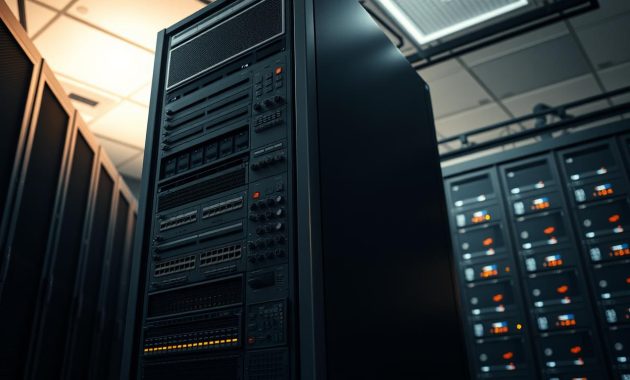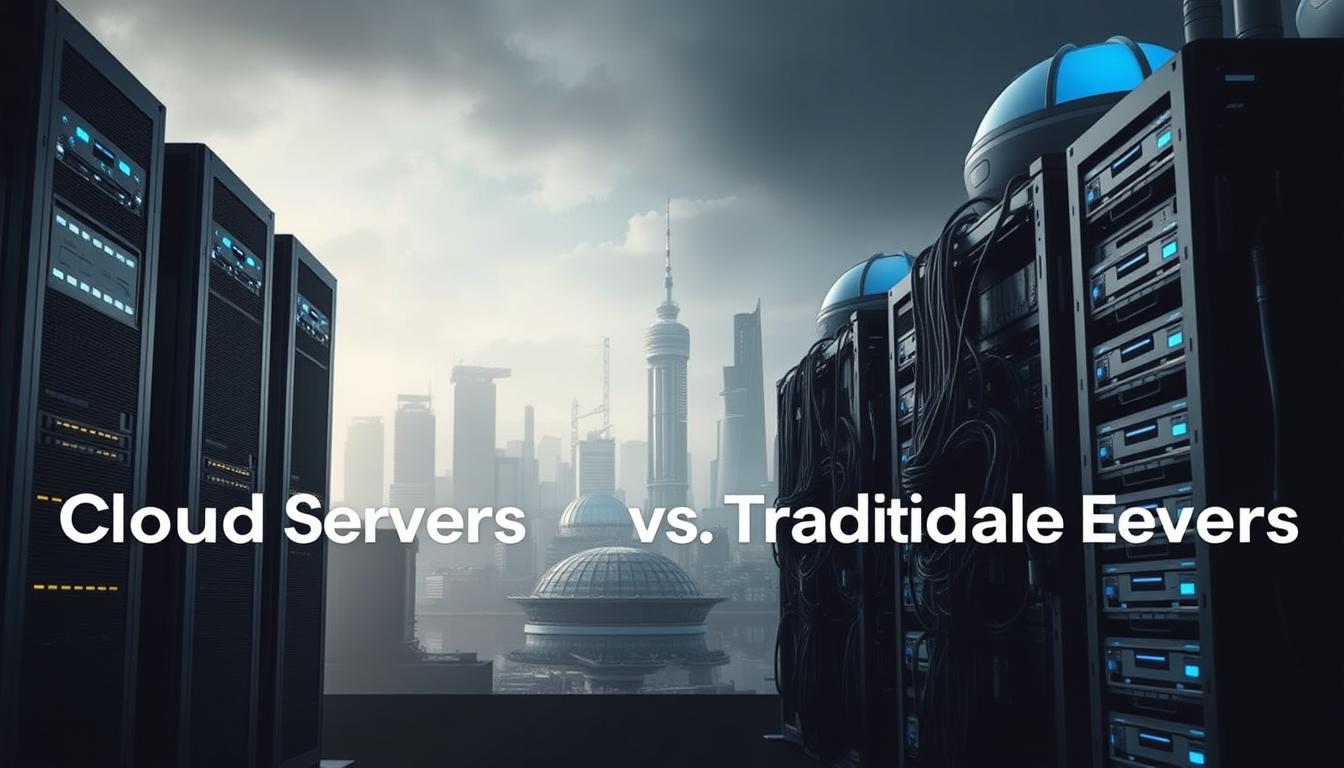In the realm of server infrastructure, discerning between cloud servers and traditional servers is paramount for businesses. A detailed server comparison is crucial for making an informed decision. Cloud servers stand out with their scalability and flexibility, making them ideal for businesses with variable demands. Conversely, traditional servers offer a higher degree of control and security, appealing to certain organizations.
When assessing cloud servers against traditional servers, several factors come into play. These include cost-efficiency, performance, and maintenance needs. This analysis will guide you in selecting the server type that best suits your business requirements. By grasping the fundamental differences between cloud servers and traditional servers, you can make a more informed choice, thereby propelling your business forward.
Understanding Cloud Servers
In the realm of cloud computing, grasping the essence of cloud servers is paramount. These virtual servers reside within a cloud computing framework, offering scalable and on-demand computing capabilities. The cloud server definition serves as a foundational understanding, illuminating its potential to enhance your business operations. Cloud servers enable the dynamic allocation and reallocation of resources, appealing to enterprises seeking cost reduction and operational agility.
The cloud server features are meticulously crafted to foster adaptability and scalability, empowering businesses to swiftly respond to evolving demands. Key attributes include:
- Scalability: Enables effortless scaling to accommodate fluctuating requirements
- Flexibility: Offers a plethora of operating systems and configurations
- Cost-efficiency: Facilitates only the payment for utilized resources
The cloud server benefits are extensive, encompassing diminished capital expenditures, enhanced agility, and superior disaster recovery capabilities. By comprehending the cloud server’s definition, features, and advantages, you are equipped to make an informed choice regarding its suitability for your enterprise.
Understanding Traditional Servers
In the realm of server options, grasping the traditional server definition is paramount, especially when contrasted with cloud servers. These are physical entities, either housed on-premise or within data centers, serving as dedicated computing resources. Traditional servers stand out for their high performance, minimal latency, and robust security, rendering them a steadfast choice for numerous enterprises.
The control they afford is a significant advantage. Traditional servers grant users full dominion over both hardware and software, enabling customization to precise specifications. Nonetheless, this control incurs the responsibility for maintenance and upkeep, tasks that can be both time-consuming and financially burdensome. It is imperative to meticulously weigh the pros and cons of traditional servers, taking into account scalability, cost, and security considerations.
Traditional servers boast several notable features:
- High-performance capabilities
- Low latency
- Advanced security measures
- Customization options

Assessing the pros and cons of traditional servers necessitates a thorough evaluation of your organization’s unique requirements and objectives. While they present numerous advantages, they may not align with every enterprise’s needs. By comprehending the traditional server’s definition, attributes, and the associated pros and cons, you can make an informed decision regarding their suitability for your organization.
Key Differences Between Cloud and Traditional Servers
The dichotomy between cloud and traditional servers presents a myriad of distinctions, paramount among them being server scalability. Cloud servers exhibit a dynamic capacity to adapt to evolving demands, a feature that traditional servers lack, necessitating manual interventions or the acquisition of new hardware. This adaptability is indispensable for entities experiencing variable traffic volumes or computational requirements.
Regarding cost-efficiency, cloud servers’ pay-as-you-go model stands as a more economical alternative to the substantial initial investments required for traditional servers. Furthermore, cloud servers offer enhanced maintenance and management functionalities, including automated software updates and patch management. Such capabilities significantly alleviate administrative burdens and minimize downtime.
- Increased flexibility and scalability
- Improved cost-efficiency
- Enhanced maintenance and management capabilities
Conversely, traditional servers may boast superior performance and latency, albeit at the cost of increased manual maintenance and upkeep. The decision between cloud and traditional servers hinges on your unique requirements. By evaluating factors such as server scalability and cost-efficiency, you can make a well-informed choice that aligns with your business objectives.
Security Considerations
In the realm of server selection, security emerges as a paramount concern. The imperative to safeguard data against unauthorized access, theft, or degradation cannot be overstated. Both cloud and traditional servers present unique security landscapes, each with its own set of advantages and vulnerabilities. Cloud servers boast a suite of protective measures, including encryption, firewalls, and access controls, designed to shield your data. Conversely, traditional servers often offer more sophisticated security features, such as dedicated hardware and on-premise security solutions.
Regarding data compliance, both cloud and traditional servers must adhere to stringent industry standards, including HIPAA and PCI-DSS. It is essential to verify that your server provider is compliant with these regulations to avert potential legal or financial repercussions. 
Several critical factors must be weighed when evaluating cloud server security and traditional server security:
- Cloud server security: encryption, firewalls, access controls, and regular security updates
- Traditional server security: dedicated hardware, on-premise security solutions, and regular security audits
- Data compliance: HIPAA, PCI-DSS, and other relevant industry standards
By meticulously examining these elements, you can make a well-informed choice regarding the most suitable server type for your enterprise. This decision will ensure the protection and compliance of your data with pertinent regulations.
Use Cases for Each Server Type
The choice between cloud and traditional servers hinges on your unique requirements. Cloud server use cases excel in scenarios demanding scalability, adaptability, and economical efficiency, such as web applications or complex data analytics. Conversely, traditional server use cases are more appropriate for applications necessitating superior performance, minimal latency, and robust security, like financial transactions or the storage of sensitive data.
In the process of server selection, several critical factors must be weighed:
- Scalability and flexibility: Cloud servers are paramount for applications experiencing variable traffic or resource needs.
- Cost-efficiency: Cloud servers offer a cost-effective solution with their pay-as-you-go pricing model.
- Performance and security: Traditional servers are preferred for applications requiring high performance, low latency, and enhanced security.
By meticulously evaluating these factors and your specific use case, you can make a well-informed decision. This will enable you to select the most suitable server infrastructure for your enterprise.
Conclusion: Making the Right Choice
In deliberating between cloud servers and traditional servers, a meticulous evaluation of your enterprise’s distinct needs is paramount. The assessment of scalability, cost-effectiveness, performance, and security is imperative. This scrutiny enables a nuanced understanding of each server type’s inherent advantages and limitations, facilitating an informed decision that resonates with your organization’s strategic objectives.
Factors to Consider in Your Decision
Optimal server infrastructure selection necessitates a comprehensive evaluation of your company’s dimensions, growth trajectory, data management and processing exigencies, and financial constraints. Furthermore, the degree of control and customization desired, alongside adherence to regulatory mandates, must be considered. A thorough analysis of these factors will enable the identification of the most appropriate server solution for your enterprise.
Future Trends in Server Technology
The evolution of server technology heralds a plethora of innovations that will significantly impact your decision-making framework. Trends such as edge computing, artificial intelligence, and quantum computing are poised to revolutionize server infrastructure paradigms. Staying abreast of these advancements ensures that your server selection remains congruent with the cutting-edge industry developments and your long-term business vision.
